高考英语书面表达常用句型-牛津英语[上下学期通用]
文档属性
| 名称 | 高考英语书面表达常用句型-牛津英语[上下学期通用] |  | |
| 格式 | rar | ||
| 文件大小 | 160.9KB | ||
| 资源类型 | 教案 | ||
| 版本资源 | 通用版 | ||
| 科目 | 英语 | ||
| 更新时间 | 2006-11-02 20:12:00 | ||
图片预览

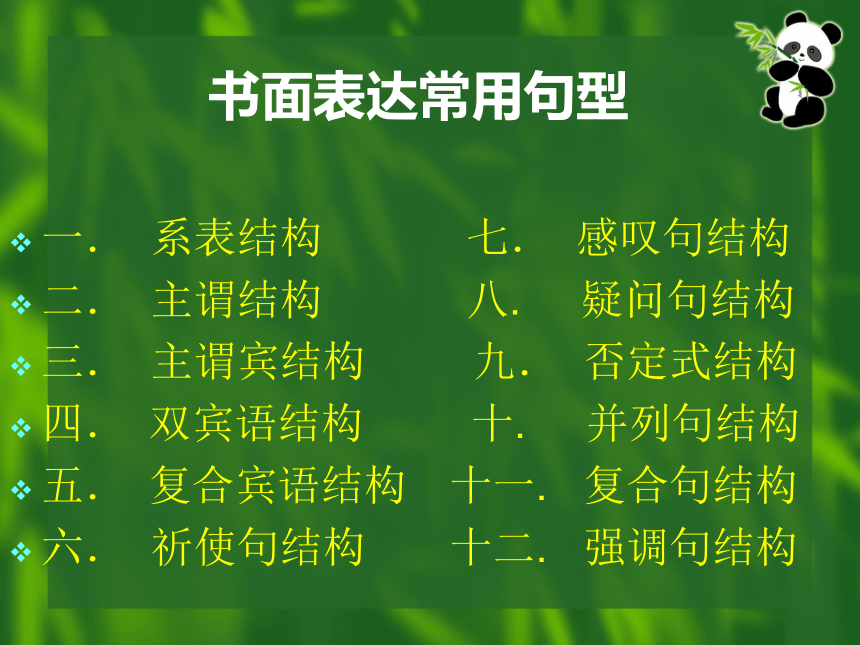

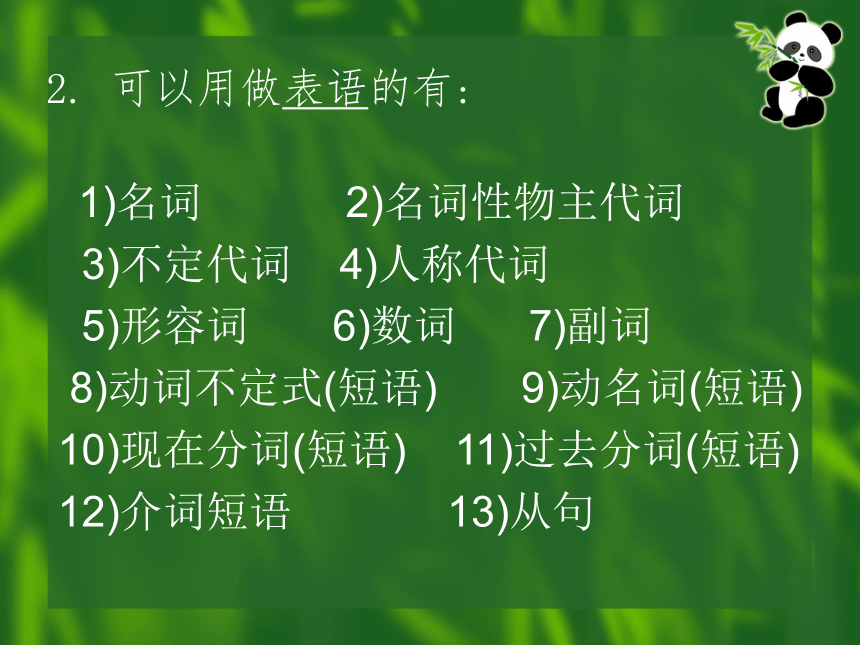
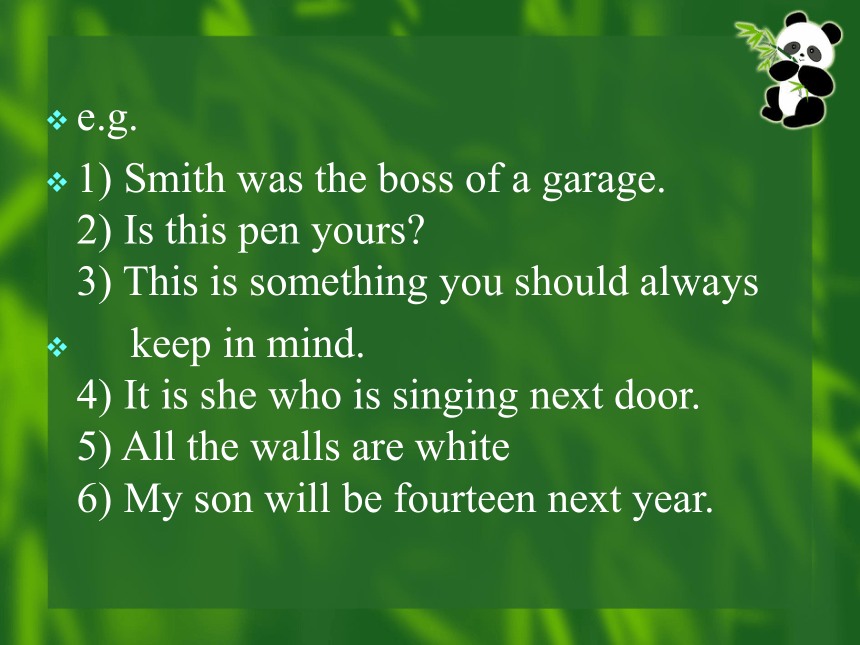
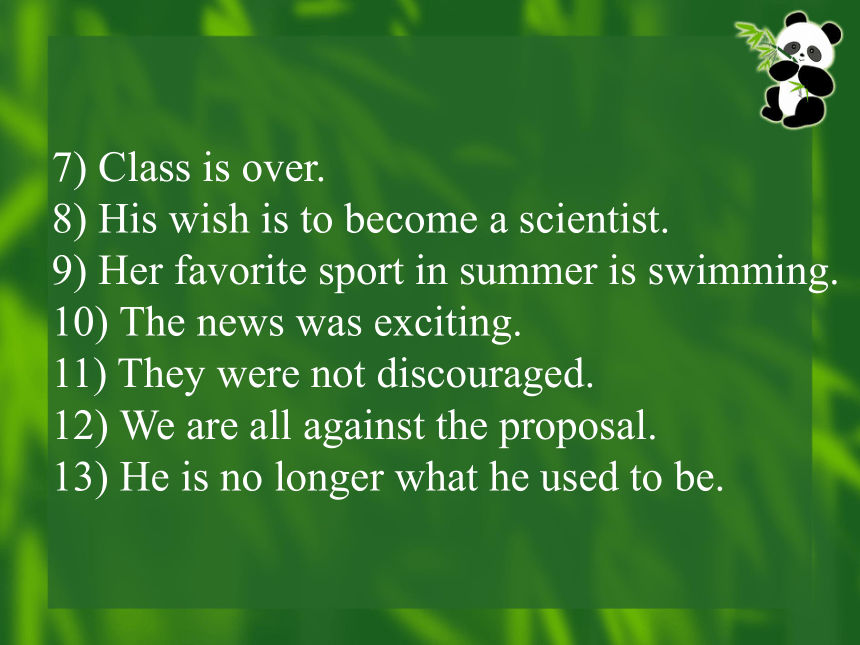


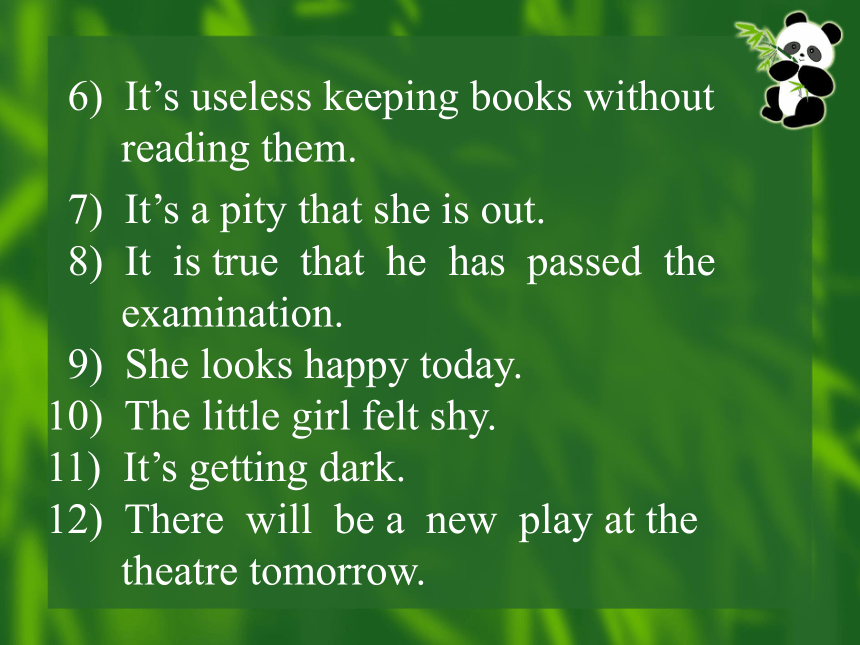
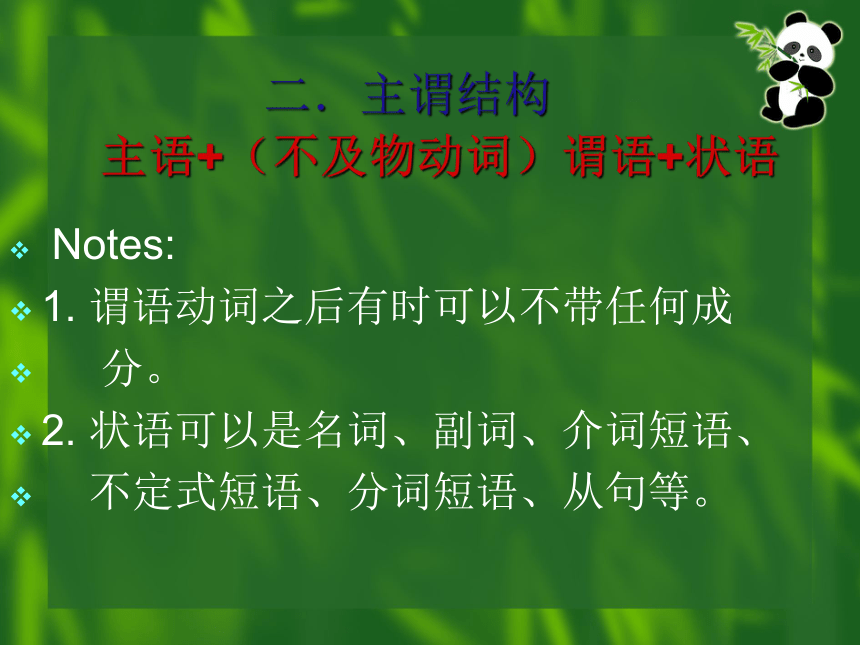
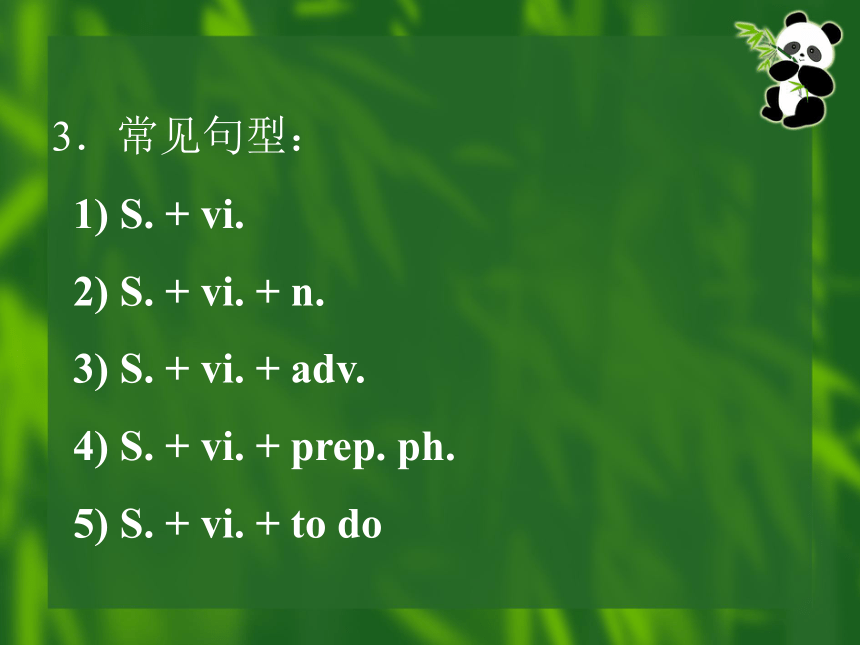
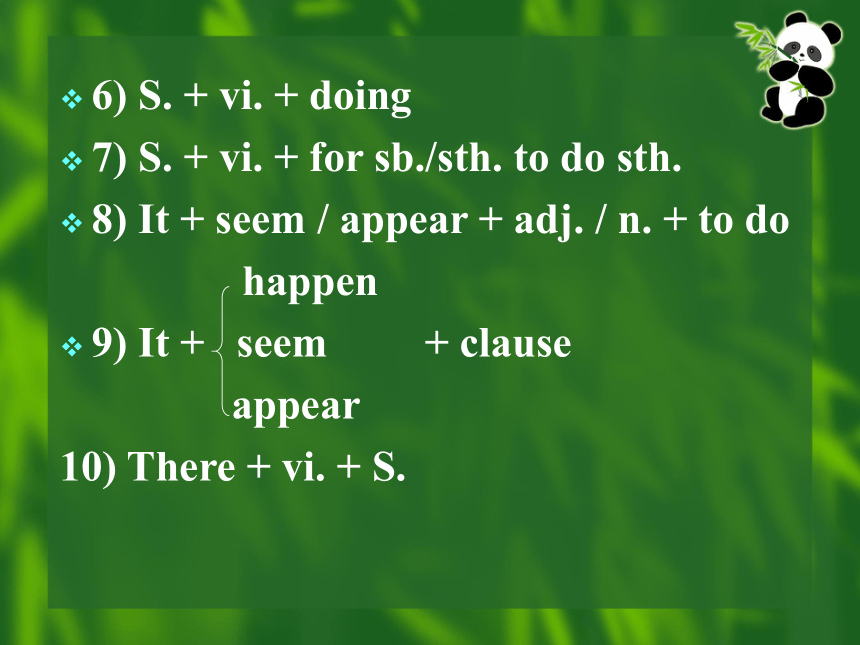
文档简介
(共98张PPT)
书面表达常用句型
书面表达常用句型
一. 系表结构 七. 感叹句结构
二. 主谓结构 八. 疑问句结构
三. 主谓宾结构 九. 否定式结构
四. 双宾语结构 十. 并列句结构
五. 复合宾语结构 十一. 复合句结构
六. 祈使句结构 十二. 强调句结构
一. 系表结构
主语+系动词+表语
Notes
1. 常用的系动词有: 1). 静态(表性质、特征、状态):
be seem remain appear 2). 动态(表变化): become go turn get grow 3). 感官(表示感觉): look sound taste feel smell
2. 可以用做表语的有:
1)名词 2)名词性物主代词
3)不定代词 4)人称代词
5)形容词 6)数词 7)副词
8)动词不定式(短语) 9)动名词(短语)
10)现在分词(短语) 11)过去分词(短语)
12)介词短语 13)从句
e.g.
1) Smith was the boss of a garage. 2) Is this pen yours 3) This is something you should always
keep in mind. 4) It is she who is singing next door. 5) All the walls are white 6) My son will be fourteen next year.
7) Class is over. 8) His wish is to become a scientist. 9) Her favorite sport in summer is swimming. 10) The news was exciting. 11) They were not discouraged. 12) We are all against the proposal. 13) He is no longer what he used to be.
3. 常用句型:
1) It + be + n. + to do 2) It + be + adj. + to do 3) It + be + n. + for / of sb. + to do 4) It + be + n. + doing 5) It + be + adj. + doing 6) It + be + n. + clause 7) It + be + adj. + clause 8) There + be + S.
e.g.
1) It is a pity to hear that. 2) It is not easy to master a foreign language. 3) It is a big mistake for her to have bought
the clothes. 4) It was hard for him to support such a big
family. 5) It is no use going there today.
6) It’s useless keeping books without
reading them.
7) It’s a pity that she is out.
8) It is true that he has passed the
examination.
9) She looks happy today.
10) The little girl felt shy.
11) It’s getting dark.
12) There will be a new play at the
theatre tomorrow.
二.主谓结构
主语+(不及物动词)谓语+状语
Notes:
1. 谓语动词之后有时可以不带任何成
分。
2. 状语可以是名词、副词、介词短语、
不定式短语、分词短语、从句等。
3.常见句型:
1) S. + vi.
2) S. + vi. + n.
3) S. + vi. + adv.
4) S. + vi. + prep. ph.
5) S. + vi. + to do
6) S. + vi. + doing
7) S. + vi. + for sb./sth. to do sth.
8) It + seem / appear + adj. / n. + to do
happen
9) It + seem + clause
appear
10) There + vi. + S.
e.g.
The sun has risen.
They worked day and night.
They all went out.
She came into the library.
He got up early to catch the first bus.
She stood smiling at me.
It seemed impossible to solve the problem.
8) She waited for her husband to come back.
9) It happened that they were out when we
called on them that evening.
10) It seems that the boy has realized the
importance of learning a foreign
language.
11) Long, long ago there lived a king.
三.主谓宾结构
主语+(及物动词)谓语+宾语
Notes:
1. vi.+ prep.== vt.
2. 可以做宾语的有:名词,代词,
数词,动词不定式,动名词,
从句等.
常见句型:
1) S.+ vt. + n.
2) S.+ vt. + pron.
3) S.+ vt. + num.
4) S.+ vt. + adv. + n. / pron.
5) S.+ vt. + to do
6) S.+ vt. + whether / wh + to do
三.主谓宾结构
7) S.+ vt. + doing
8) S.+ vt. + object clause
9) S.+ vt. + object + prep. ph.
10) S.+ vt. + it + prep. ph. + that clause
11) S.+ vt. + object + to do
12) It+ vt. + object + to do
13) S.+ vt. + it + adj. / n. ( + for sb.) + to do
e.g.
1) She is watering the flowers.
2) He loves her very much.
3) Who are you going to take these three
4) She couldn’t keep back her tears.
==She couldn’t keep her tears back.
5) She decided to give it up.
6) He tried to do a good deed each day.
7) She hardly knows how to write a
composition.
8) I wondered whether to stay or to leave.
9) I remember seeing her somewhere before.
10) I hear (that) she has come back.
11) I agree to what he has said.
12) He didn’t know whose side he should take.
13) We spend a lot of money on books.
14) He explained it to his students that he was ill
that day.
15) He entered the room to look for his pencil-box.
16) It took more than ten years to build the houses.
17) I think it necessary (for him) to learn a foreign
language.
四.双宾语结构
主语+(及物动词)谓语+间接宾语+直接宾语
Notes:
1. 不是所有的及物动词之后都可由双宾语。
可用于此句型的动词有以下三类:
1). give tell teach write bring
lend hand show send offer
pay pass allow
2) buy do get fetch save make
sing choose
3) ask answer
2. 1)= vt. + D.O. + to + I.O.
2)= vt. + D.O. + for + I.O.
3)vt. + D.O.1 + D.O.2
3.常用句型:
1) S. + vt. + D.O. +I.O.
2) S. + vt. + D.O. + to / for + I.O.
3) S. + vt. + I.O. + clause
4) It take + O. ( n. / pron.) + n. /pron. + to do
5) Sth. + cost + sb. + n.
e.g.
1) He gave me some beautiful pictures.
2) He handed the purse to the teacher.
3) Would you fetch some water for the
children
4) She told the students (that) the old
man was her father.
5) We’ll show you whose order it is.
6) It took him quite some time to find
the elephant at all.
7) The new bike cost him 300 yuan.
五.复合宾语结构
主语+(及物动词)谓语+复合宾语
Notes:
1.复合宾语是指“宾语+宾语补足语”。
宾语和其补足语之间存在着逻辑上的
主谓关系。
2.可作宾语补足语的有:名词,形容词,
副词,介词短语,动词不定时,现在
分词,过去分词。
3.常见句型:
1) S. + vt. + n. / pron. + n.
pain
get
beat
find
2) S. + vt. drive + n. / pron. + adj.
wish
prove
leave
make
feel
hear
listen to
make
let
7) S. + vt. see + object + do
look at
watch
notice
observe
8) S. + vt. + object + doing
feel
find
3) S.+ vt. make +it + n./adj. + for/of sb. to do /doing
think
consider
4) S. + vt. + adj. / n. + that clause
n.
5) S. + vt. + pron. + to be + adj./n.
clause
6) S. + vt. + object + to do
9) S. + vt. + object + done
10) S. + vt. + object + W + to do
11) S. + vt. + object + adv.
12) S. + vt. + sb. / one’s + doing
13) S. + vt. + object + prep. ph.
e.g.
1) We elected him monitor of our class.
2) The boy kicked the door open.
3) I think it foolish of him to believe her.
4) We thought it better for you to take the
medicine in time.
5) He had made it a rule never to cast his
net more than three times a day.
6) I consider it a pity that he has given up
studying English.
7) We found her to be mad.
8) He wanted her to be a dancer.
9) He believes what she said to be true.
10) The doctor advised him to have an
operation.
11) The boss made the workers work long
hours.
12) We found the boy crying in the street.
13) Have you ever heard this song sung in
English
14) The farmers showed us how to cut
wheat.
15) Did you find them in
16) Do you mind me /my closing the
window
17) They forced her into the room.
六.祈使句结构
1. Do + …
2. Be + predictive +…
3. Don’t + do + …
4. Don’t + be + predictive
5. Let + object + do + ...
e.g. 1) Come in, please.
2) Pass her a piece of paper.
3) Be a good boy.
4) Be careful not to touch it.
5) Don’t read in a moving bus.
6) Don’t be so silly.
7) Let’s have a rest.
8) Let the boy in, please.
七.感叹句结构
1. What (+ adj.) + n.+ S. + v.!
2. How + adj./adv. + S. + v.!
3. How + S. + v.!
4. How + adj.+ a / an + n. + S. + v.!
e.g. 1) What a silly boy he is!
2) What terrible weather we are having!
3) How hard they are working!
4) How wonderful to be invited to a
palace ball!
八.疑问句结构
1.一般疑问句:
1) Be + S. + predictive
2) Be + there + S. + …
Have
3) Has + S. + object + …
Had
Do
Be
4) Have + S. + do + …
Will
Shall
Can
May
5) Must + S. + do +…
Need
Dare
e.g. 1) Were they busy yesterday
2) Was there a pine tree beside the house
3) Have you (got) any red ink
4) Is she lying in bed
5) Did Tom go there with you
6) Dare you say it again
2. 特殊疑问句
1)作主语的疑问词 + 陈述语序
(who; which; what)
2)作定语修饰主语的疑问词 + 陈述语序?
(what; which; whose; how many/much)
3)疑问词(作定语/表语/状语)+一般疑问语序?
e.g. 1) Who came to school the earliest
yesterday
2) Which book is yours
3) What are you doing
4) Where did you go yesterday
3.选择疑问句:
1)一般疑问句 + or + 另一供选择部分?
2)一般疑问句 + or + not
3)特殊疑问句, + A or B
e.g. 1) Do you like sports or music
2) Do you like sports or not
3)Which is bigger, the sun or the moon
4. 反意疑问句:
助动词
1)陈述句肯定结构,+ 系动词 的否定式 + 人称代词?
情态动词
助动词
2)陈述句否定结构,+ 系动词 的肯定式 + 人称代词?
情态动词
e.g. 1) You are tired, aren’t you
2) You wouldn’t leave for long, will you
九.否定式结构
1.S. + be + not + predictive.
e.g. He is not an engineer.
have no
2. S. + has + not a + object .
had any
e.g. I have no brother.
no
3. There + be + not a + S.
not any
e.g. There isn’t a book on the table.
4. S. + do/does/did + not + do
e.g. He didn’t come to school yesterday.
5. S. + 助动词 + not + do
e.g. 1) He is not crying.
2) I shall not ask him for help.
6. S. + 情态动词 + not + do
e.g. You needn’t worry.
to do
7. not + doing +…
done
e.g. 1) Not knowing the truth, he scolded her.
2) I regretted not attending the meeting.
3) We said so not to flatter(奉承) him.
all
both
8. not + each 部分否定
every
the whole
完全否定分别用:
none , neither, nothing, nobody, no one
e.g.
1) All the answers are not correct.
2) Everything doesn’t go well.
3) She hasn’t done the job completely.
4) Nobody can work it out.
5) None of the students is from Shanghai.
9. 由nor, neither构成否定承接句:
Neither / Nor + 助/系/情态动词 + S.
Note:
如果前句两个或两个以上动词不属同类、时态不一致或既有肯定又有否定,则套用句型: It is / was the same with + S.
e.g. 1) I don’t like the film, nor does she.
2) He has no time. Neither have I.
10. 由hardly, seldom, rarely, never, little, few等构成的含否定意义的句子。
e.g. 1) He hardly went out shopping.
2) Few of them know science.
十. 并列句结构
1. 由并列词或逗号、分号把两个或两个以上、具有逻辑关系的简单句连
接为一体,就构成了并列句。
2. 常用的并列连词有:
and “和”
or “否则”
but “可是;但是”
for “因为” so “因此”
either… or… “不是…就是…”
neither … nor … “ 既不…也不…”
not only… but also… “不但…而且…”
3.常用的副词有:
yet “但是”
however “然而”
therefore “所以”
Note: 此类词前常有逗号或分号与前句分开。
e.g. 1) Hurry up! It’s going to rain.
2) He had to come back home; he wanted
some money.
3) Tears appeared in her eyes, but he didn’t
notice it.
4) Spring came and the trees turned green.
5) She must be ill, for she didn’t come
to school this morning.
6) He found nobody in the room, so he
went away.
7) He is old, yet he is still active in his
work.
8) The composition is all right; however
there is room for improvement.
9) He was very tired, and therefore he fell
sound asleep.
10) We must hurry, or we’ll be late.
11) Either he is wrong or you are wrong.
12) He doesn’t know her, nor do I.
13) Not only was my mother angry, but my
father also.
十一. 复合句结构
1. 主语从句结构:
1) 连接代词/副词 + 从句 + 主句谓语部分
== It + 主句谓语部分 + 连接代词/副词 + 从句
(常用连词 that; whether; who; whom; whose;
which; when; where; why; how)
e.g.
1) That we love peace is known to all.
==It is known to all that we love peace.
2) Whether we can solve the difficulty still
remains a question.
==It still remains a question whether we
can solve the difficulty.
3) Whose composition is better is hard to say.
==It is hard to say whose composition is
better.
4) Where we’ll spend the summer holidays has
not been decided.
==It hasn’t been decided where we’ll spend
the summer holidays.
2) What + 主语和及物动词谓语 + 主句谓语部分
e.g.
(1) What he said is not true.
(2) What we are doing is for building
socialism.
Whoever
3) Whatever + 主语从句 + 主句谓语部分
Whichever
e.g.
(1) Whoever wants to go may go at once.
(2) Whatever is worth doing at all is worth
doing well.
happened
seems
4)It + is a pity + that-clause
is said
is reported
e.g.
(1) It happened that he was ill when we
found him.
(2) It seems that she doesn’t like her job.
(3) It’s a pity that she has gone abroad.
(4) It is said / reported that our women’s
football team had won again.
2.表语从句结构
that
连词 if
主语 + whether + clause
连接代词( who; whom; which; what)
连接副词(when; where; why; how)
e.g.
1) His suggestion is that we go to Beijing
to spend our holidays.
2) That is just what he wants.
3) The question is who will have a try first.
4) That is why the bat never fly out in the
daytime.
5) The problem is whether we can find each
other at the station.
3. 宾语从句结构
1) S. + vt. + that-clause
e.g. ① I wish I could enter college.
② The king replied that he would set him
free.
2) S. + vt. + if / whether-clause
e.g. ① The teacher asked if anyone was absent.
② I wonder whether he will come ( or not ).
3) S. + vt. + 连接代词/副词 + clause
e.g. ① He asked which exercise is the most difficult.
② No one knows what they are fighting about.
4) S. + vt. + sb. + 连接代词/副词 + clause
e.g. ① He didn’t tell me where he lived.
② Didn’t she tell you when we should start
5) 主谓结构 + prep. + clause
e.g.
① She should be praised for what she has
done.
② The boss paid the workers according to
how much they had done for him.
6) S. + vt. + to短语 + that-clause
e.g. He explained to us that he had failed to
catch the first bus.
7) S. + vt. + it + adj. / n. + clause
e.g. ① We felt it strange that she could leave
without saying good-bye.
② We thought it a shame that they fought
each other in class.
4. 定语从句结构
1) 主句主语 + 关系代词/副词 + clause + 主句谓语
e.g.
① The man who is standing by the door
is our English teacher.
② The watch (which / that ) I bought
yesterday is made in Swiss.
③ The days when we were cheated are
gone for ever.
2) 主句 + 关系代词/副词+ clause
e.g.① This is the girl whose father died in the
flood.
② I’ll never forget the day when I joined
the Party.
3) 主句中的被修饰词 + prep. + 关系代词 + clause
e.g. ① The earth on which we live is a big ball.
② We visited the house in which chairman
Mao once lived.
4) 非限定性定语从句:
which
who
主句中的被修饰词 + , + whom + clause
whose + n.
where
e.g.
① Wang Hai’s father, who works in
Nanjing, has come back home.
② We visited the industrial exhibition,
where we saw a lot of foreign guests.
5. 状语从句结构:
1) 时间状语从句
(1) conj. + clause + , + 主句
主句 + conj. + clause
(用于此类从句的连词有:when, while, as,
before, after, since, until, as soon as)
e.g.
① when he saw his mother, the boy began
to cry.
② I’ll write to you as soon as I get there.
(2) S. + had no sooner + done + than + clause
No sooner had + S. + done + than + clause
e.g.
The bell had no sooner rung than the
teacher walked into the classroom.
==No sooner had the bell rung than the
teacher walked into the classroom.
(3) Hardly + had + S. + done + when / before + clause
S. + had + hardly + done + when / before + clause
e.g.
Hardly had I got home when / before it began to
rain.
==I had hardly got home when / before it began
to rain.
(4) Scarcely + had + S. + done + when / before + clause
S. + had + scarcely + done + when / before + clause
e.g.
Scarcely had he got to bed when / before he fell to
sleep.
== He had scarcely got to bed when / before he
fell to sleep.
2) 地点状语从句
主句 + where(ever) + 从句
Where(ver) + 从句+,+ 主句
e.g.
① I lost my pen where I wrote my composition.
② Wherever we are sent to work, we should
work hard.
3)原因状语从句
Because / As / Since / Now that + 从句,+主句
主句 + because / as / since / now that + 从句
e.g.
① He didn’t go to the meeting because he was ill.
② As it is going to rain, you’d better stay at home.
4)条件状语从句
If / Unless / As long as + clause +, + 主句
主句 + if / unless / as long as + 从句
e.g.
① You are sure to succeed if you work hard.
② As / So long as we keep calm, we can find
a way out.
5)结果状语从句
① 主句 + that / so that + 从句
② S. + v. + so + adj. / adv. + that-clause
③ S. + v. + such (a) + adj. + n. + that-clause
④ S. + v. + so + adj. (+ a ) + n. + that-clause
e.g.
① She is so kind to us that we all love her.
② He spoke so quickly that nobody could
follow him.
③ She gave us such an excellent lecture that
everybody admired him.
==She gave us so excellent a lecture that
everybody admired him.
6)目的状语从句
that
so that
主句 + in order that + 从句
in case
e.g. We took the front seats in order that we
could hear clearly.
7)让步状语从句
(1) conj. + clause +, + 主句
==主句 + conj. + clause
adj.
(2) adv. + as / though + 从句 + 主句
n.
常用连词有:
though (although) “虽然”
even if/though “即使”
whether … or … “不管事…还是…”
whoever (no matter who ) “无论谁”
whatever (no matter what ) “无论什么”
whichever (no matter which ) “无论哪个”
whenever ( no matter when) “无论何时”
wherever ( no matter where) “无论何地”
7)让步状语从句
e.g.
① She took care of the patients though she
herself was also ill.
② No matter where you go, you must find
time to study.
③ Young as he is, he knows a lot.
8)方式状语从句
主句 + as / as if + clause
e.g. ① Let’s study as Lenin studied.
② He spoke as if he were a professor.
9)比较状语从句
(1)同级比较状语从句
S. + v. (+ not) + as / so + adj. / adv. + as + clause
e.g.
① He works as hard as Jack.
② The police were not as / so light-hearted
as Tom.
(2) 比较级状语从句
S. + v. (+ no) + adj.-er /adv.-er + than + clause
e.g.
① He can jump higher than I.
② There are more students in Class One
than in Class Two.
③ It is no more hot today than yesterday.
(3) 表示递进的比较状语从句
The + adj.-er / adv.-er +, + the + adj.-er / adv.-er
e.g.
The harder he works, the happier he is.
(4)表示最高级概念的比较状语从句
否定意义主语 + v. + adj. / adv + as + clause
否定意义主语 + v. + adj. / adv. + than + clause
e.g.
① Nobody is so sly (狡猾) as he is.
② No one studies harder than he does.
6. 同位语从句
主句主语 + 谓语 + 宾语 + that + clause
主句主语 + that + clause + 主句谓语
e.g. ① We all know the fact that the earth
moves around the sun.
② The news that the Chinese women’s
volleyball team has won the world’s
championship soon spread over the
whole country.
十二. 强调句结构
It is / was + 被强调部分 + that + 句子剩余部分
Note:
1. 本结构用于强调除谓语以外的句子成分。要
强调谓语动词可用: S. + do/does/did + V.+…
2. 原因状语从句被强调时只可由because引导。
3. 含not … until… 的复合句套用:
It is / was not until … that …
(被强调部分用陈述语序)
e.g.
① It was your sister that I met in the zoo
yesterday.
② It was yesterday that I met your sister
in the zoo.
Thank you!
书面表达常用句型
书面表达常用句型
一. 系表结构 七. 感叹句结构
二. 主谓结构 八. 疑问句结构
三. 主谓宾结构 九. 否定式结构
四. 双宾语结构 十. 并列句结构
五. 复合宾语结构 十一. 复合句结构
六. 祈使句结构 十二. 强调句结构
一. 系表结构
主语+系动词+表语
Notes
1. 常用的系动词有: 1). 静态(表性质、特征、状态):
be seem remain appear 2). 动态(表变化): become go turn get grow 3). 感官(表示感觉): look sound taste feel smell
2. 可以用做表语的有:
1)名词 2)名词性物主代词
3)不定代词 4)人称代词
5)形容词 6)数词 7)副词
8)动词不定式(短语) 9)动名词(短语)
10)现在分词(短语) 11)过去分词(短语)
12)介词短语 13)从句
e.g.
1) Smith was the boss of a garage. 2) Is this pen yours 3) This is something you should always
keep in mind. 4) It is she who is singing next door. 5) All the walls are white 6) My son will be fourteen next year.
7) Class is over. 8) His wish is to become a scientist. 9) Her favorite sport in summer is swimming. 10) The news was exciting. 11) They were not discouraged. 12) We are all against the proposal. 13) He is no longer what he used to be.
3. 常用句型:
1) It + be + n. + to do 2) It + be + adj. + to do 3) It + be + n. + for / of sb. + to do 4) It + be + n. + doing 5) It + be + adj. + doing 6) It + be + n. + clause 7) It + be + adj. + clause 8) There + be + S.
e.g.
1) It is a pity to hear that. 2) It is not easy to master a foreign language. 3) It is a big mistake for her to have bought
the clothes. 4) It was hard for him to support such a big
family. 5) It is no use going there today.
6) It’s useless keeping books without
reading them.
7) It’s a pity that she is out.
8) It is true that he has passed the
examination.
9) She looks happy today.
10) The little girl felt shy.
11) It’s getting dark.
12) There will be a new play at the
theatre tomorrow.
二.主谓结构
主语+(不及物动词)谓语+状语
Notes:
1. 谓语动词之后有时可以不带任何成
分。
2. 状语可以是名词、副词、介词短语、
不定式短语、分词短语、从句等。
3.常见句型:
1) S. + vi.
2) S. + vi. + n.
3) S. + vi. + adv.
4) S. + vi. + prep. ph.
5) S. + vi. + to do
6) S. + vi. + doing
7) S. + vi. + for sb./sth. to do sth.
8) It + seem / appear + adj. / n. + to do
happen
9) It + seem + clause
appear
10) There + vi. + S.
e.g.
The sun has risen.
They worked day and night.
They all went out.
She came into the library.
He got up early to catch the first bus.
She stood smiling at me.
It seemed impossible to solve the problem.
8) She waited for her husband to come back.
9) It happened that they were out when we
called on them that evening.
10) It seems that the boy has realized the
importance of learning a foreign
language.
11) Long, long ago there lived a king.
三.主谓宾结构
主语+(及物动词)谓语+宾语
Notes:
1. vi.+ prep.== vt.
2. 可以做宾语的有:名词,代词,
数词,动词不定式,动名词,
从句等.
常见句型:
1) S.+ vt. + n.
2) S.+ vt. + pron.
3) S.+ vt. + num.
4) S.+ vt. + adv. + n. / pron.
5) S.+ vt. + to do
6) S.+ vt. + whether / wh + to do
三.主谓宾结构
7) S.+ vt. + doing
8) S.+ vt. + object clause
9) S.+ vt. + object + prep. ph.
10) S.+ vt. + it + prep. ph. + that clause
11) S.+ vt. + object + to do
12) It+ vt. + object + to do
13) S.+ vt. + it + adj. / n. ( + for sb.) + to do
e.g.
1) She is watering the flowers.
2) He loves her very much.
3) Who are you going to take these three
4) She couldn’t keep back her tears.
==She couldn’t keep her tears back.
5) She decided to give it up.
6) He tried to do a good deed each day.
7) She hardly knows how to write a
composition.
8) I wondered whether to stay or to leave.
9) I remember seeing her somewhere before.
10) I hear (that) she has come back.
11) I agree to what he has said.
12) He didn’t know whose side he should take.
13) We spend a lot of money on books.
14) He explained it to his students that he was ill
that day.
15) He entered the room to look for his pencil-box.
16) It took more than ten years to build the houses.
17) I think it necessary (for him) to learn a foreign
language.
四.双宾语结构
主语+(及物动词)谓语+间接宾语+直接宾语
Notes:
1. 不是所有的及物动词之后都可由双宾语。
可用于此句型的动词有以下三类:
1). give tell teach write bring
lend hand show send offer
pay pass allow
2) buy do get fetch save make
sing choose
3) ask answer
2. 1)= vt. + D.O. + to + I.O.
2)= vt. + D.O. + for + I.O.
3)vt. + D.O.1 + D.O.2
3.常用句型:
1) S. + vt. + D.O. +I.O.
2) S. + vt. + D.O. + to / for + I.O.
3) S. + vt. + I.O. + clause
4) It take + O. ( n. / pron.) + n. /pron. + to do
5) Sth. + cost + sb. + n.
e.g.
1) He gave me some beautiful pictures.
2) He handed the purse to the teacher.
3) Would you fetch some water for the
children
4) She told the students (that) the old
man was her father.
5) We’ll show you whose order it is.
6) It took him quite some time to find
the elephant at all.
7) The new bike cost him 300 yuan.
五.复合宾语结构
主语+(及物动词)谓语+复合宾语
Notes:
1.复合宾语是指“宾语+宾语补足语”。
宾语和其补足语之间存在着逻辑上的
主谓关系。
2.可作宾语补足语的有:名词,形容词,
副词,介词短语,动词不定时,现在
分词,过去分词。
3.常见句型:
1) S. + vt. + n. / pron. + n.
pain
get
beat
find
2) S. + vt. drive + n. / pron. + adj.
wish
prove
leave
make
feel
hear
listen to
make
let
7) S. + vt. see + object + do
look at
watch
notice
observe
8) S. + vt. + object + doing
feel
find
3) S.+ vt. make +it + n./adj. + for/of sb. to do /doing
think
consider
4) S. + vt. + adj. / n. + that clause
n.
5) S. + vt. + pron. + to be + adj./n.
clause
6) S. + vt. + object + to do
9) S. + vt. + object + done
10) S. + vt. + object + W + to do
11) S. + vt. + object + adv.
12) S. + vt. + sb. / one’s + doing
13) S. + vt. + object + prep. ph.
e.g.
1) We elected him monitor of our class.
2) The boy kicked the door open.
3) I think it foolish of him to believe her.
4) We thought it better for you to take the
medicine in time.
5) He had made it a rule never to cast his
net more than three times a day.
6) I consider it a pity that he has given up
studying English.
7) We found her to be mad.
8) He wanted her to be a dancer.
9) He believes what she said to be true.
10) The doctor advised him to have an
operation.
11) The boss made the workers work long
hours.
12) We found the boy crying in the street.
13) Have you ever heard this song sung in
English
14) The farmers showed us how to cut
wheat.
15) Did you find them in
16) Do you mind me /my closing the
window
17) They forced her into the room.
六.祈使句结构
1. Do + …
2. Be + predictive +…
3. Don’t + do + …
4. Don’t + be + predictive
5. Let + object + do + ...
e.g. 1) Come in, please.
2) Pass her a piece of paper.
3) Be a good boy.
4) Be careful not to touch it.
5) Don’t read in a moving bus.
6) Don’t be so silly.
7) Let’s have a rest.
8) Let the boy in, please.
七.感叹句结构
1. What (+ adj.) + n.+ S. + v.!
2. How + adj./adv. + S. + v.!
3. How + S. + v.!
4. How + adj.+ a / an + n. + S. + v.!
e.g. 1) What a silly boy he is!
2) What terrible weather we are having!
3) How hard they are working!
4) How wonderful to be invited to a
palace ball!
八.疑问句结构
1.一般疑问句:
1) Be + S. + predictive
2) Be + there + S. + …
Have
3) Has + S. + object + …
Had
Do
Be
4) Have + S. + do + …
Will
Shall
Can
May
5) Must + S. + do +…
Need
Dare
e.g. 1) Were they busy yesterday
2) Was there a pine tree beside the house
3) Have you (got) any red ink
4) Is she lying in bed
5) Did Tom go there with you
6) Dare you say it again
2. 特殊疑问句
1)作主语的疑问词 + 陈述语序
(who; which; what)
2)作定语修饰主语的疑问词 + 陈述语序?
(what; which; whose; how many/much)
3)疑问词(作定语/表语/状语)+一般疑问语序?
e.g. 1) Who came to school the earliest
yesterday
2) Which book is yours
3) What are you doing
4) Where did you go yesterday
3.选择疑问句:
1)一般疑问句 + or + 另一供选择部分?
2)一般疑问句 + or + not
3)特殊疑问句, + A or B
e.g. 1) Do you like sports or music
2) Do you like sports or not
3)Which is bigger, the sun or the moon
4. 反意疑问句:
助动词
1)陈述句肯定结构,+ 系动词 的否定式 + 人称代词?
情态动词
助动词
2)陈述句否定结构,+ 系动词 的肯定式 + 人称代词?
情态动词
e.g. 1) You are tired, aren’t you
2) You wouldn’t leave for long, will you
九.否定式结构
1.S. + be + not + predictive.
e.g. He is not an engineer.
have no
2. S. + has + not a + object .
had any
e.g. I have no brother.
no
3. There + be + not a + S.
not any
e.g. There isn’t a book on the table.
4. S. + do/does/did + not + do
e.g. He didn’t come to school yesterday.
5. S. + 助动词 + not + do
e.g. 1) He is not crying.
2) I shall not ask him for help.
6. S. + 情态动词 + not + do
e.g. You needn’t worry.
to do
7. not + doing +…
done
e.g. 1) Not knowing the truth, he scolded her.
2) I regretted not attending the meeting.
3) We said so not to flatter(奉承) him.
all
both
8. not + each 部分否定
every
the whole
完全否定分别用:
none , neither, nothing, nobody, no one
e.g.
1) All the answers are not correct.
2) Everything doesn’t go well.
3) She hasn’t done the job completely.
4) Nobody can work it out.
5) None of the students is from Shanghai.
9. 由nor, neither构成否定承接句:
Neither / Nor + 助/系/情态动词 + S.
Note:
如果前句两个或两个以上动词不属同类、时态不一致或既有肯定又有否定,则套用句型: It is / was the same with + S.
e.g. 1) I don’t like the film, nor does she.
2) He has no time. Neither have I.
10. 由hardly, seldom, rarely, never, little, few等构成的含否定意义的句子。
e.g. 1) He hardly went out shopping.
2) Few of them know science.
十. 并列句结构
1. 由并列词或逗号、分号把两个或两个以上、具有逻辑关系的简单句连
接为一体,就构成了并列句。
2. 常用的并列连词有:
and “和”
or “否则”
but “可是;但是”
for “因为” so “因此”
either… or… “不是…就是…”
neither … nor … “ 既不…也不…”
not only… but also… “不但…而且…”
3.常用的副词有:
yet “但是”
however “然而”
therefore “所以”
Note: 此类词前常有逗号或分号与前句分开。
e.g. 1) Hurry up! It’s going to rain.
2) He had to come back home; he wanted
some money.
3) Tears appeared in her eyes, but he didn’t
notice it.
4) Spring came and the trees turned green.
5) She must be ill, for she didn’t come
to school this morning.
6) He found nobody in the room, so he
went away.
7) He is old, yet he is still active in his
work.
8) The composition is all right; however
there is room for improvement.
9) He was very tired, and therefore he fell
sound asleep.
10) We must hurry, or we’ll be late.
11) Either he is wrong or you are wrong.
12) He doesn’t know her, nor do I.
13) Not only was my mother angry, but my
father also.
十一. 复合句结构
1. 主语从句结构:
1) 连接代词/副词 + 从句 + 主句谓语部分
== It + 主句谓语部分 + 连接代词/副词 + 从句
(常用连词 that; whether; who; whom; whose;
which; when; where; why; how)
e.g.
1) That we love peace is known to all.
==It is known to all that we love peace.
2) Whether we can solve the difficulty still
remains a question.
==It still remains a question whether we
can solve the difficulty.
3) Whose composition is better is hard to say.
==It is hard to say whose composition is
better.
4) Where we’ll spend the summer holidays has
not been decided.
==It hasn’t been decided where we’ll spend
the summer holidays.
2) What + 主语和及物动词谓语 + 主句谓语部分
e.g.
(1) What he said is not true.
(2) What we are doing is for building
socialism.
Whoever
3) Whatever + 主语从句 + 主句谓语部分
Whichever
e.g.
(1) Whoever wants to go may go at once.
(2) Whatever is worth doing at all is worth
doing well.
happened
seems
4)It + is a pity + that-clause
is said
is reported
e.g.
(1) It happened that he was ill when we
found him.
(2) It seems that she doesn’t like her job.
(3) It’s a pity that she has gone abroad.
(4) It is said / reported that our women’s
football team had won again.
2.表语从句结构
that
连词 if
主语 + whether + clause
连接代词( who; whom; which; what)
连接副词(when; where; why; how)
e.g.
1) His suggestion is that we go to Beijing
to spend our holidays.
2) That is just what he wants.
3) The question is who will have a try first.
4) That is why the bat never fly out in the
daytime.
5) The problem is whether we can find each
other at the station.
3. 宾语从句结构
1) S. + vt. + that-clause
e.g. ① I wish I could enter college.
② The king replied that he would set him
free.
2) S. + vt. + if / whether-clause
e.g. ① The teacher asked if anyone was absent.
② I wonder whether he will come ( or not ).
3) S. + vt. + 连接代词/副词 + clause
e.g. ① He asked which exercise is the most difficult.
② No one knows what they are fighting about.
4) S. + vt. + sb. + 连接代词/副词 + clause
e.g. ① He didn’t tell me where he lived.
② Didn’t she tell you when we should start
5) 主谓结构 + prep. + clause
e.g.
① She should be praised for what she has
done.
② The boss paid the workers according to
how much they had done for him.
6) S. + vt. + to短语 + that-clause
e.g. He explained to us that he had failed to
catch the first bus.
7) S. + vt. + it + adj. / n. + clause
e.g. ① We felt it strange that she could leave
without saying good-bye.
② We thought it a shame that they fought
each other in class.
4. 定语从句结构
1) 主句主语 + 关系代词/副词 + clause + 主句谓语
e.g.
① The man who is standing by the door
is our English teacher.
② The watch (which / that ) I bought
yesterday is made in Swiss.
③ The days when we were cheated are
gone for ever.
2) 主句 + 关系代词/副词+ clause
e.g.① This is the girl whose father died in the
flood.
② I’ll never forget the day when I joined
the Party.
3) 主句中的被修饰词 + prep. + 关系代词 + clause
e.g. ① The earth on which we live is a big ball.
② We visited the house in which chairman
Mao once lived.
4) 非限定性定语从句:
which
who
主句中的被修饰词 + , + whom + clause
whose + n.
where
e.g.
① Wang Hai’s father, who works in
Nanjing, has come back home.
② We visited the industrial exhibition,
where we saw a lot of foreign guests.
5. 状语从句结构:
1) 时间状语从句
(1) conj. + clause + , + 主句
主句 + conj. + clause
(用于此类从句的连词有:when, while, as,
before, after, since, until, as soon as)
e.g.
① when he saw his mother, the boy began
to cry.
② I’ll write to you as soon as I get there.
(2) S. + had no sooner + done + than + clause
No sooner had + S. + done + than + clause
e.g.
The bell had no sooner rung than the
teacher walked into the classroom.
==No sooner had the bell rung than the
teacher walked into the classroom.
(3) Hardly + had + S. + done + when / before + clause
S. + had + hardly + done + when / before + clause
e.g.
Hardly had I got home when / before it began to
rain.
==I had hardly got home when / before it began
to rain.
(4) Scarcely + had + S. + done + when / before + clause
S. + had + scarcely + done + when / before + clause
e.g.
Scarcely had he got to bed when / before he fell to
sleep.
== He had scarcely got to bed when / before he
fell to sleep.
2) 地点状语从句
主句 + where(ever) + 从句
Where(ver) + 从句+,+ 主句
e.g.
① I lost my pen where I wrote my composition.
② Wherever we are sent to work, we should
work hard.
3)原因状语从句
Because / As / Since / Now that + 从句,+主句
主句 + because / as / since / now that + 从句
e.g.
① He didn’t go to the meeting because he was ill.
② As it is going to rain, you’d better stay at home.
4)条件状语从句
If / Unless / As long as + clause +, + 主句
主句 + if / unless / as long as + 从句
e.g.
① You are sure to succeed if you work hard.
② As / So long as we keep calm, we can find
a way out.
5)结果状语从句
① 主句 + that / so that + 从句
② S. + v. + so + adj. / adv. + that-clause
③ S. + v. + such (a) + adj. + n. + that-clause
④ S. + v. + so + adj. (+ a ) + n. + that-clause
e.g.
① She is so kind to us that we all love her.
② He spoke so quickly that nobody could
follow him.
③ She gave us such an excellent lecture that
everybody admired him.
==She gave us so excellent a lecture that
everybody admired him.
6)目的状语从句
that
so that
主句 + in order that + 从句
in case
e.g. We took the front seats in order that we
could hear clearly.
7)让步状语从句
(1) conj. + clause +, + 主句
==主句 + conj. + clause
adj.
(2) adv. + as / though + 从句 + 主句
n.
常用连词有:
though (although) “虽然”
even if/though “即使”
whether … or … “不管事…还是…”
whoever (no matter who ) “无论谁”
whatever (no matter what ) “无论什么”
whichever (no matter which ) “无论哪个”
whenever ( no matter when) “无论何时”
wherever ( no matter where) “无论何地”
7)让步状语从句
e.g.
① She took care of the patients though she
herself was also ill.
② No matter where you go, you must find
time to study.
③ Young as he is, he knows a lot.
8)方式状语从句
主句 + as / as if + clause
e.g. ① Let’s study as Lenin studied.
② He spoke as if he were a professor.
9)比较状语从句
(1)同级比较状语从句
S. + v. (+ not) + as / so + adj. / adv. + as + clause
e.g.
① He works as hard as Jack.
② The police were not as / so light-hearted
as Tom.
(2) 比较级状语从句
S. + v. (+ no) + adj.-er /adv.-er + than + clause
e.g.
① He can jump higher than I.
② There are more students in Class One
than in Class Two.
③ It is no more hot today than yesterday.
(3) 表示递进的比较状语从句
The + adj.-er / adv.-er +, + the + adj.-er / adv.-er
e.g.
The harder he works, the happier he is.
(4)表示最高级概念的比较状语从句
否定意义主语 + v. + adj. / adv + as + clause
否定意义主语 + v. + adj. / adv. + than + clause
e.g.
① Nobody is so sly (狡猾) as he is.
② No one studies harder than he does.
6. 同位语从句
主句主语 + 谓语 + 宾语 + that + clause
主句主语 + that + clause + 主句谓语
e.g. ① We all know the fact that the earth
moves around the sun.
② The news that the Chinese women’s
volleyball team has won the world’s
championship soon spread over the
whole country.
十二. 强调句结构
It is / was + 被强调部分 + that + 句子剩余部分
Note:
1. 本结构用于强调除谓语以外的句子成分。要
强调谓语动词可用: S. + do/does/did + V.+…
2. 原因状语从句被强调时只可由because引导。
3. 含not … until… 的复合句套用:
It is / was not until … that …
(被强调部分用陈述语序)
e.g.
① It was your sister that I met in the zoo
yesterday.
② It was yesterday that I met your sister
in the zoo.
Thank you!
